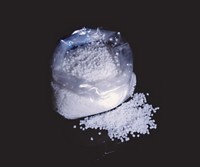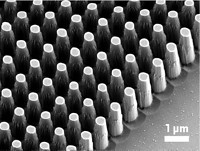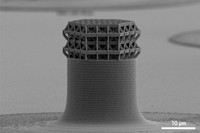Advertisement
Grab your lab coat. Let's get started
Welcome!
Welcome!
Create an account below to get 6 C&EN articles per month, receive newsletters and more - all free.
It seems this is your first time logging in online. Please enter the following information to continue.
As an ACS member you automatically get access to this site. All we need is few more details to create your reading experience.
Not you? Sign in with a different account.
Not you? Sign in with a different account.
ERROR 1
ERROR 1
ERROR 2
ERROR 2
ERROR 2
ERROR 2
ERROR 2
Password and Confirm password must match.
If you have an ACS member number, please enter it here so we can link this account to your membership. (optional)
ERROR 2
ACS values your privacy. By submitting your information, you are gaining access to C&EN and subscribing to our weekly newsletter. We use the information you provide to make your reading experience better, and we will never sell your data to third party members.
3-D Printing
Ceramic lattices that are stronger than diamond
New design based on interconnected plates pushes theoretical strength limits
by Prachi Patel, special to C&EN
April 1, 2020
| A version of this story appeared in
Volume 98, Issue 13

To make ultrastrong yet lightweight materials for aerospace components, researchers have in the past decade created complex 3-D lattices that are mostly air but gain strength from their intricate constructs of beams and trusses. Now a team reports pushing these lattices to their ultimate limit, generating a ceramic material that’s as strong as theorists believe to be physically possible. The material is stronger than diamond while being up to 70 percent air (Nat. Commun. 2020, DOI: 10.1038/s41467-020-15434-2).
While earlier lattices were made up of cylindrical beams, the new design uses connected ceramic plates. This design makes it 639% stronger and 522% stiffer than the best beam-based lattices. In fact, it boasts the highest strength theoretically possible for any such architected materials, says Jens Bauer, a mechanical and aerospace engineer at the University of California, Irvine.
In order to understand why the plate lattice is stronger than one made of beams, Bauer suggests a thought experiment. Imagine three beams intersecting perpendicularly to make a node. Pushing down on one of the beams only puts pressure on that beam—the other two can’t take on any of the pressure. Plates can be more supportive of one another. Imagine three plates intersecting to form a corner. If you push down in one direction, two plates bear the brunt. “In a beam-based design, one-third of the material is doing the work while in a plate-based design two-thirds of the material is,” he says.
Researchers have known for some time that these plate-based lattices were promising, but they have been challenging to design and produce. To make the material, the researchers use a commercially available 3-D printing technique called two-photon lithography direct laser writing. They start with a mix of a UV light-sensitive acrylate resin that solidifies into a polymer only at spots where two photons meet simultaneously, together providing enough energy to trigger the reaction. This method is particularly good at making features with nanoscale resolution.
By projecting the laser beams through the resin, the researchers create a 3-D lattice made of repeated cells, each with six square faces and eight triangular ones. The plates that make these faces are as thin as 160 nm. They have tiny holes in their centers that allow the researchers to remove leftover resin to clean off the completed material—a simple fix to a problem that had previously prevented researchers from making these sorts of structures. Once the laser writing is done, the researchers heat the structure at 900 °C for an hour in a vacuum. This leaves behind a cube-shaped lattice of pyrolytic carbon, a glassy ceramic.
The microscopic cubes are around 20 µm on each side, about a quarter the diameter of a human hair. Tests show that the material has a specific strength of 3.75 GPa g–1 cm3, stronger by weight than diamond and at the highest strength theoretically possible for a porous material of this density.
The design principle is not scale dependent so it should work with larger structures, Bauer says. That is, once it’s possible to make them. Creating bigger structures would require a different 3-D printing technique; the laser-based one used to make the prototypes is too slow.
Meanwhile, the small amounts of material that can currently be manufactured might find use in microelectromechanical systems (MEMS) devices such as sensors, says Tobias Schaedler, director of the Center for Additive Materials at HRL Laboratories. “This work is important scientifically and from a practical application standpoint,” he adds.
CORRECTION
This story was updated on April 2, 2020, to correct the units of specific strength. They are GPa g–1 cm3, not GPa g–1/cm3





Join the conversation
Contact the reporter
Submit a Letter to the Editor for publication
Engage with us on Twitter